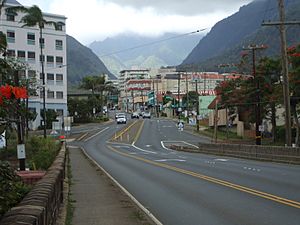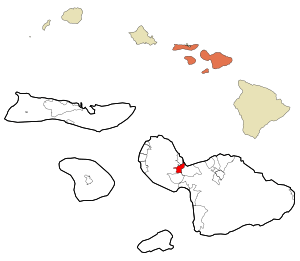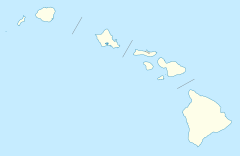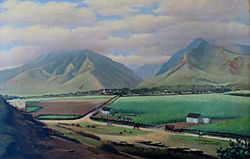Wailuku, Hawaii facts for kids
Quick facts for kids
Wailuku, Hawaii
|
|
|---|---|

Wailuku, looking from the Wai'ale Drive Bridge towards ʻĪao Valley.
|
|

Location in Maui County and the state of Hawaii
|
|
| Country | United States |
| State | Hawaii |
| County | Maui |
| Area | |
| • Total | 5.67 sq mi (14.69 km2) |
| • Land | 5.26 sq mi (13.64 km2) |
| • Water | 0.41 sq mi (1.06 km2) |
| Elevation | 249 ft (76 m) |
| Population
(2020)
|
|
| • Total | 17,697 |
| • Density | 3,361.25/sq mi (1,297.71/km2) |
| Time zone | UTC-10 (Hawaii-Aleutian) |
| ZIP code |
96793
|
| Area code(s) | 808 |
| FIPS code | 15-77450 |
| GNIS feature ID | 0364757 |
Wailuku is a town in Maui County, Hawaii, United States. It is the main town, or county seat, of Maui Island. In 2020, about 17,697 people lived there.
Wailuku is located west of Kahului, near the entrance to the beautiful Iao Valley. Long ago, in the early 1900s, Wailuku was the most popular place for tourists on Maui. Later, other resort towns like Kaanapali became more famous.
The town has many historic places. These include the Kaʻahumanu Church, built in 1876 and named after Queen Kaʻahumanu, who was the wife of Kamehameha I. You can also find the Wailuku Civic Center Historic District, the old Chee Kung Tong Society Building, and the Bailey House. The Bailey House was once a school and a home in the 1800s. Now, it is a history museum run by the Maui Historical Society.
Near Wailuku, there are two ancient Hawaiian temples called heiau. These are the Halekiʻi Heiau and the Pihanakalani Heiau. They are hundreds of years old and were important religious sites for the native Hawaiian people.
Kahului Airport serves the town of Wailuku.
Contents
Where is Wailuku Located?
Wailuku is found at about 20.89 degrees North and 156.50 degrees West. It is between the towns of Waihee-Waiehu to the north, Kahului to the east, and Waikapu to the south.
The town sits about 76 meters (249 feet) above sea level. It is at the base of the West Maui Mountains, also known as Mauna Kahalawai. Wailuku is on the northern edge of the narrow strip of land that connects East Maui (Haleakalā) and West Maui.
The United States Census Bureau says that Wailuku covers a total area of 14.8 square kilometers (5.7 square miles). About 13.8 square kilometers (5.3 square miles) of this is land, and 1.1 square kilometers (0.4 square miles) is water.
West Maui has three main areas called moku: Lāhaina, Kāʻanapali, and Wailuku. Wailuku is also known as Pūʻalikomohana, or Nā Wai ʻEhā, which means "the four waters." These four waters refer to smaller land divisions called ahupuaʻa: Waikapū, Wailuku, Waiʻehu, and Waiheʻe.
A Look Back at Wailuku's History
Wailuku was a very important place in ancient Hawaii. It was home to Maui's most famous Hawaiian rulers. In 1790, a big battle happened here called the Battle of Kepaniwai in the Iao Valley. In this battle, Kamehameha the Great won against the Maui army. This victory helped him unite all the Hawaiian islands. The battle was so fierce that dead bodies blocked the ʻĪao Stream. Because of this, the battle site was named Kepaniwai, meaning "the damming of the waters."
In the mid-1800s, things changed a lot. Missionaries from New England came to Hawaii. They brought new religious ideas, Western tools, and new ways of farming. By the 1860s, the Wailuku Sugar Company and other farms were busy growing and processing sugarcane. Many miles of ditches were dug to bring water from the mountains to the large sugar fields. The sugar industry grew very quickly.
Thousands of workers came to Maui from all over the world to work in the sugar fields and factories. They came from China, Japan, Korea, the Philippines, Europe, and America. These workers brought many different cultures and religions to their new home. Many of them settled in Wailuku. Houses, schools, churches, temples, shops, and banks were built to serve this growing town.
In 1905, Wailuku became the main town for Maui County. It quickly became a center for government, business, and fun. It had theaters, a bowling alley, hotels, and many shops. This growth continued until the late 1960s. At that time, the sugar industry became less important, and new shopping areas opened up. This caused some businesses to move away from downtown Wailuku.
Many buildings in Wailuku have special architectural and historical meaning. You can find charming old bungalows with colorful gardens on the narrow streets. On upper Main Street, which leads to Iao Valley, you can still see parts of the missionary era. There is a small graveyard with tombstones of Hawaiian royalty and missionary families. Further up the hill are the Alexander House and the Bailey House. The Bailey House is now a great museum with ancient Hawaiian artifacts and rooms showing how missionaries lived.
The Hawaiian name Wailuku means "destroying water." The Hawaiian god Kāne is seen as the creator and giver of life. He is linked to fresh water, clouds, rain, and streams. Kanaloa, the Hawaiian god of the underworld, is represented by the stone of the ʻĪao Needle.
People of Wailuku
| Historical population | |||
|---|---|---|---|
| Census | Pop. | %± | |
| 2000 | 12,296 | — | |
| 2010 | 15,313 | 24.5% | |
| 2020 | 17,697 | 15.6% | |
| U.S. Decennial Census | |||
In 2000, there were 12,296 people living in Wailuku. There were 4,535 households and 3,015 families. The population density was about 937 people per square kilometer (2,427 people per square mile).
The people of Wailuku come from many different backgrounds:
- 42.08% were Asian
- 26.28% were from two or more races
- 11.70% were Pacific Islander
- 8.16% were White
- 7.75% were Hispanic or Latino
- 1.18% were from other races
- 0.36% were Native American
- 0.24% were African American
About 29.1% of households had children under 18 living with them. The average household had 2.71 people, and the average family had 3.28 people.
The population was spread out by age:
- 23.7% were under 18
- 7.1% were 18 to 24
- 30.3% were 25 to 44
- 23.9% were 45 to 64
- 15.1% were 65 or older
The average age was 38 years. For every 100 females, there were about 99.4 males.
The average income for a household in Wailuku was $45,587. For a family, it was $51,441. About 11.2% of the population lived below the poverty line.
What is the Economy Like in Wailuku?
Wailuku has several major employers. These include:
- Towne Island Homes
- Maui Memorial Medical Center
- Kaiser Permanente
- Maui County government
- The Pacific Whale Foundation
- Maui Ocean Center
- The Maui News newspaper
- Maui Community Correctional Center
- Bayada Home Health Care
Sports in Wailuku
Wailuku is the hometown of two famous Major League Baseball players: Shane Victorino and Kurt Suzuki. Both players have won the World Series with their teams. Victorino won in 2008 and 2013, and Suzuki won in 2019. From 2010 to 2013, Wailuku even had its own baseball team called Na Koa Ikaika Maui.
The Maui Bowling Center is also in Wailuku. It opened in 1948 and has hosted many local bowling leagues. When it first opened, people had to set the pins by hand! In 1961, it got automatic pin-setting machines.
Places to Visit in Wailuku
- Iao Theater
- Iao Valley
- Tropical Gardens of Maui
- Duke "The Duke" Kahanamoku's (Ambassador of Aloha) Surfboard at The Bailey House Museum
See also
 In Spanish: Wailuku para niños
In Spanish: Wailuku para niños





